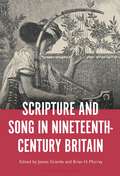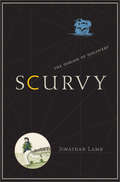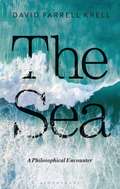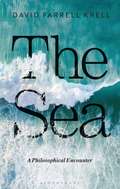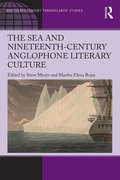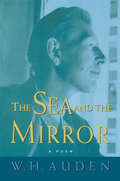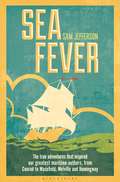- Table View
- List View
Scripture and Song in Nineteenth-Century Britain
by James Grande and Brian H. MurrayThis volume brings together new approaches to music history to reveal the interdependence of music and religion in nineteenth-century culture. As composers and performers drew inspiration from the Bible and new historical sciences called into question the historicity of Scripture, controversies raged over the performance, publication and censorship of old and new musical forms. From oratorio to opera, from parlour song to pantomime, and from hymn to broadside, nineteenth-century Britons continually encountered elements of the biblical past in song. Both elite and popular music came to play a significant role in the formation, regulation and contestation of religious and cultural identity and were used to address questions of class, nation and race, leading to the beginnings of ethnomusicology. This richly interdisciplinary volume brings together musicologists, historians, literary and art historians and theologians to reveal points of intersection between music, religion and cultural history.
Scripture and Song in Nineteenth-Century Britain
This volume brings together new approaches to music history to reveal the interdependence of music and religion in nineteenth-century culture. As composers and performers drew inspiration from the Bible and new historical sciences called into question the historicity of Scripture, controversies raged over the performance, publication and censorship of old and new musical forms. From oratorio to opera, from parlour song to pantomime, and from hymn to broadside, nineteenth-century Britons continually encountered elements of the biblical past in song. Both elite and popular music came to play a significant role in the formation, regulation and contestation of religious and cultural identity and were used to address questions of class, nation and race, leading to the beginnings of ethnomusicology. This richly interdisciplinary volume brings together musicologists, historians, literary and art historians and theologians to reveal points of intersection between music, religion and cultural history.
Scripture, Canon and Commentary: A Comparison of Confucian and Western Exegesis
by John B. HendersonIn this major contribution to the study of the Chinese classics and comparative religion, John Henderson uses the history of exegesis to illuminate mental patterns that have universal and perennial significance for intellectual history. Henderson relates the Confucian commentarial tradition to other primary exegetical traditions, particularly the Homeric tradition, Vedanta, rabbinic Judaism, ancient and medieval Christian biblical exegesis, and Qur'anic exegesis. In making such comparisons, he discusses some basic assumptions common to all these traditions--such as that the classics or scriptures are comprehensive or that they contain all significant knowledge or truth and analyzes the strategies deployed to support these presuppositions. As shown here, primary differences among commentarial or exegetical traditions arose from variations in their emphasis on one or another of these assumptions and strategies. Henderson demonstrates that exegetical modes of thought were far from arcane: they dominated the post-classical/premodern intellectual world. Some have persisted or re-emerged in modern times, particularly in ideologies such as Marxism. Written in an engaging and accessible style, Scripture, Canon, and Commentary is not only a challenging interpretation of comparative scriptural traditions but also an excellent introduction to the study of the Confucian classics.Originally published in 1991.The Princeton Legacy Library uses the latest print-on-demand technology to again make available previously out-of-print books from the distinguished backlist of Princeton University Press. These editions preserve the original texts of these important books while presenting them in durable paperback and hardcover editions. The goal of the Princeton Legacy Library is to vastly increase access to the rich scholarly heritage found in the thousands of books published by Princeton University Press since its founding in 1905.
The Scriptures of Charles Dickens: Novels of Ideology, Novels of the Self (The Nineteenth Century Series)
by Vincent NeweyThis study focuses on Dickens's response to questions of identity, conduct, and social organization that emerged in an era of major cultural unsettlement and change, not least with the decline of religious certainty and the rise of materialism. An analysis of A Christmas Carol as a paradigm of his concerns and strategies in these fields is followed by close readings of novels from different stages of his career, Oliver Twist, David Copperfield, Great Expectations and Our Mutual Friend. These, and other works by Dickens, are seen to reflect ideologies currently at work in his society but also, more importantly, to participate in the construction of needful value systems and codes for regulating behaviour. Liberal humanism and middle-class hegemony feature largely in this process of culture formation, where Dickens played a crucial role in formulating and promulgating such salient guiding principles as those of sympathy, marriage and the family, economic responsibility, and hierarchy within and between groups. His treatment of the self is on one level driven by this project in shaping and stabilizing attitudes among a confederacy of readers, in that it offers positive models of development, of how to function and fit in; yet on another, especially in his sustained imaginative preoccupation with the figure of the outsider or misfit, this is one pre-eminent area where his writing transcends purposes of enculturation and paradoxically challenges its own ideological positions. His female characters in particular, as well as more obviously his anti-heroes, criminals, and other dissidents, are shown to question and subvert the moulds in which they are formally cast. The novels are confirmed not only as great creative achievements, an aspect this book consistently salutes, nor simply as a primary site of the evolving Victorian dispensation and revolution of ideas, but as a territory that predicts, engages, and illuminates our own complex modernity. Reference is made throughout the volume to other contemporary writings, including sociological, philosophic, and medical discourse, to recent cognate theory, and to traditions, like that of Puritan spiritual autobiography, which Dickens adapted to new ends.
The Scriptures of Charles Dickens: Novels of Ideology, Novels of the Self (The Nineteenth Century Series)
by Vincent NeweyThis study focuses on Dickens's response to questions of identity, conduct, and social organization that emerged in an era of major cultural unsettlement and change, not least with the decline of religious certainty and the rise of materialism. An analysis of A Christmas Carol as a paradigm of his concerns and strategies in these fields is followed by close readings of novels from different stages of his career, Oliver Twist, David Copperfield, Great Expectations and Our Mutual Friend. These, and other works by Dickens, are seen to reflect ideologies currently at work in his society but also, more importantly, to participate in the construction of needful value systems and codes for regulating behaviour. Liberal humanism and middle-class hegemony feature largely in this process of culture formation, where Dickens played a crucial role in formulating and promulgating such salient guiding principles as those of sympathy, marriage and the family, economic responsibility, and hierarchy within and between groups. His treatment of the self is on one level driven by this project in shaping and stabilizing attitudes among a confederacy of readers, in that it offers positive models of development, of how to function and fit in; yet on another, especially in his sustained imaginative preoccupation with the figure of the outsider or misfit, this is one pre-eminent area where his writing transcends purposes of enculturation and paradoxically challenges its own ideological positions. His female characters in particular, as well as more obviously his anti-heroes, criminals, and other dissidents, are shown to question and subvert the moulds in which they are formally cast. The novels are confirmed not only as great creative achievements, an aspect this book consistently salutes, nor simply as a primary site of the evolving Victorian dispensation and revolution of ideas, but as a territory that predicts, engages, and illuminates our own complex modernity. Reference is made throughout the volume to other contemporary writings, including sociological, philosophic, and medical discourse, to recent cognate theory, and to traditions, like that of Puritan spiritual autobiography, which Dickens adapted to new ends.
Scriptwriting 2.0: Writing for the Digital Age
by Marie DrennanOnline media is and will continue to be at the forefront of entertainment; this book introduces readers to this new world and helps them create good content for it. It is a compact, practical guide for those who want to explore scriptwriting for the digital age while also learning essential skills and techniques central to new media writing. Scriptwriting 2.0 contains advice on writing both short- and long-form webisodes as part of a series, as well as standalone pieces. It then goes beyond the writing process to discuss revising, production, promotion and copyright. It is written in a friendly, readable and jargon-free style and includes real-world examples from successful series and a sample script. Readers can access full episodes of the two series discussed at length as well as samples from several other web series.
Scriptwriting 2.0: Writing for the Digital Age
by Marie DrennanOnline media is and will continue to be at the forefront of entertainment; this book introduces readers to this new world and helps them create good content for it. It is a compact, practical guide for those who want to explore scriptwriting for the digital age while also learning essential skills and techniques central to new media writing. Scriptwriting 2.0 contains advice on writing both short- and long-form webisodes as part of a series, as well as standalone pieces. It then goes beyond the writing process to discuss revising, production, promotion and copyright. It is written in a friendly, readable and jargon-free style and includes real-world examples from successful series and a sample script. Readers can access full episodes of the two series discussed at length as well as samples from several other web series.
Scriptwriting for Film, Television and New Media
by Alan C. HuethWhat are the foundations of scriptwriting? Why do some scripts gain more prestige than others? How do you write a script and get it noticed? Scriptwriting for Film, Television and New Media answers these questions and more, offering a comprehensive introduction to writing scripts for film, television, the Internet, and interactive multimedia. Author Alan C. Hueth explains not just how to write, but how to think and apply the fundamental principles of screenwriting to multiple platforms and genres. This includes chapters on numerous script formats, including drama and comedy in film and TV, short films, commercials and PSAs, news and sports, interview shows, documentaries, reality shows, and corporate and educational media, including interactive multimedia. This book also addresses legal and ethical issues, how to become a professional scriptwriter, and a section on production language that provides helpful explanations of how camera, locations, visual and audio effects combine on screen to engage and sustain viewer attention, and, consequently, how to improve scriptwriting technique. The book features numerous case studies and detailed examples, including chapter by chapter exercises, plot diagrams, quick-look and learn tables that assist readers to quickly understand genre related script elements, and in-depth script close-ups to examine precisely how writers utilize the principles and elements of drama to create a successful script. It is also supported by a comprehensive companion website with further case studies, assignments, video clips, and examples of films and programs discussed in the book. Scriptwriting for Film, Television, and New Media is ideal for aspiring scriptwriters and anyone wanting to broaden their understanding of how successful scripts are created.
Scriptwriting for Film, Television and New Media
by Alan C. HuethWhat are the foundations of scriptwriting? Why do some scripts gain more prestige than others? How do you write a script and get it noticed? Scriptwriting for Film, Television and New Media answers these questions and more, offering a comprehensive introduction to writing scripts for film, television, the Internet, and interactive multimedia. Author Alan C. Hueth explains not just how to write, but how to think and apply the fundamental principles of screenwriting to multiple platforms and genres. This includes chapters on numerous script formats, including drama and comedy in film and TV, short films, commercials and PSAs, news and sports, interview shows, documentaries, reality shows, and corporate and educational media, including interactive multimedia. This book also addresses legal and ethical issues, how to become a professional scriptwriter, and a section on production language that provides helpful explanations of how camera, locations, visual and audio effects combine on screen to engage and sustain viewer attention, and, consequently, how to improve scriptwriting technique. The book features numerous case studies and detailed examples, including chapter by chapter exercises, plot diagrams, quick-look and learn tables that assist readers to quickly understand genre related script elements, and in-depth script close-ups to examine precisely how writers utilize the principles and elements of drama to create a successful script. It is also supported by a comprehensive companion website with further case studies, assignments, video clips, and examples of films and programs discussed in the book. Scriptwriting for Film, Television, and New Media is ideal for aspiring scriptwriters and anyone wanting to broaden their understanding of how successful scripts are created.
Scriptwriting for Web Series: Writing for the Digital Age
by Marie Drennan Yuri Baranovsky Vlad BaranovskyScriptwriting for Web Series: Writing for the Digital Age offers aspiring writers a comprehensive how-to guide to scriptwriting for web series in the digital age. Containing in-depth advice on writing both short- and long-form webisodes as part of a series, as well as standalone pieces, it goes beyond the screenwriting process to discuss production, promotion and copyright in order to offer a well-rounded guide to creating and distributing a successful web series. Written in a friendly, readable and jargon-free style by an experienced scriptwriting professor and two award-winning web series creators, it offers invaluable professional insights, as well as examples from successful series, sample scripts and interviews with key series creators, writers and industry professionals.
Scriptwriting for Web Series: Writing for the Digital Age
by Marie Drennan Yuri Baranovsky Vlad BaranovskyScriptwriting for Web Series: Writing for the Digital Age offers aspiring writers a comprehensive how-to guide to scriptwriting for web series in the digital age. Containing in-depth advice on writing both short- and long-form webisodes as part of a series, as well as standalone pieces, it goes beyond the screenwriting process to discuss production, promotion and copyright in order to offer a well-rounded guide to creating and distributing a successful web series. Written in a friendly, readable and jargon-free style by an experienced scriptwriting professor and two award-winning web series creators, it offers invaluable professional insights, as well as examples from successful series, sample scripts and interviews with key series creators, writers and industry professionals.
Scroungers: Moral Panics and Media Myths
by James MorrisonScroungers, spongers, parasites …These are just are some of the terms that are typically used, with increasing frequency, to describe the most vulnerable in our society, whether they be the sick, the disabled, or the unemployed. Long a popular scapegoat for all manner of social ills, under austerity we've seen hostility towards benefit claimants reach new levels of hysteria, with the 'undeserving poor' blamed for everything from crime to even rising levels of child abuse.While the tabloid press has played its role in fuelling this hysteria, the proliferation of social media has added a disturbing new dimension to this process, spreading and reinforcing scare stories, while normalising the perception of poverty as a form of 'deviancy' that runs contrary to the neoliberal agenda. Provocative and illuminating, Scroungers explores and analyses the ways in which the poor are portrayed both in print and online, placing these attitudes in a wider breakdown of social trust and community cohesion.
Scroungers: Moral Panics and Media Myths
by James MorrisonScroungers, spongers, parasites …These are just are some of the terms that are typically used, with increasing frequency, to describe the most vulnerable in our society, whether they be the sick, the disabled, or the unemployed. Long a popular scapegoat for all manner of social ills, under austerity we've seen hostility towards benefit claimants reach new levels of hysteria, with the 'undeserving poor' blamed for everything from crime to even rising levels of child abuse.While the tabloid press has played its role in fuelling this hysteria, the proliferation of social media has added a disturbing new dimension to this process, spreading and reinforcing scare stories, while normalising the perception of poverty as a form of 'deviancy' that runs contrary to the neoliberal agenda. Provocative and illuminating, Scroungers explores and analyses the ways in which the poor are portrayed both in print and online, placing these attitudes in a wider breakdown of social trust and community cohesion.
Scurvy: The Disease of Discovery
by Jonathan LambScurvy, a disease often associated with long stretches of maritime travel, generated sensations exceeding the standard of what was normal. Eyes dazzled, skin was morbidly sensitive, emotions veered between disgust and delight. In this book, Jonathan Lamb presents an intellectual history of scurvy unlike any other, probing the speechless encounter with powerful sensations to tell the story of the disease that its victims couldn't because they found their illness too terrible and, in some cases, too exciting.Drawing on historical accounts from scientists and voyagers as well as major literary works, Lamb traces the cultural impact of scurvy during the eighteenth-century age of geographical and scientific discovery. He explains the medical knowledge surrounding scurvy and the debates about its cause, prevention, and attempted cures. He vividly describes the phenomenon and experience of "scorbutic nostalgia," in which victims imagined mirages of food, water, or home, and then wept when such pleasures proved impossible to consume or reach. Lamb argues that a culture of scurvy arose in the colony of Australia, which was prey to the disease in its early years, and identifies a literature of scurvy in the works of such figures as Herman Melville, Samuel Taylor Coleridge, Francis Bacon, and Jonathan Swift.Masterful and illuminating, Scurvy shows how the journeys of discovery in the eighteenth century not only ventured outward to the ends of the earth, but were also an inward voyage into the realms of sensation and passion.
Scurvy: The Disease of Discovery
by Jonathan LambScurvy, a disease often associated with long stretches of maritime travel, generated sensations exceeding the standard of what was normal. Eyes dazzled, skin was morbidly sensitive, emotions veered between disgust and delight. In this book, Jonathan Lamb presents an intellectual history of scurvy unlike any other, probing the speechless encounter with powerful sensations to tell the story of the disease that its victims couldn't because they found their illness too terrible and, in some cases, too exciting.Drawing on historical accounts from scientists and voyagers as well as major literary works, Lamb traces the cultural impact of scurvy during the eighteenth-century age of geographical and scientific discovery. He explains the medical knowledge surrounding scurvy and the debates about its cause, prevention, and attempted cures. He vividly describes the phenomenon and experience of "scorbutic nostalgia," in which victims imagined mirages of food, water, or home, and then wept when such pleasures proved impossible to consume or reach. Lamb argues that a culture of scurvy arose in the colony of Australia, which was prey to the disease in its early years, and identifies a literature of scurvy in the works of such figures as Herman Melville, Samuel Taylor Coleridge, Francis Bacon, and Jonathan Swift.Masterful and illuminating, Scurvy shows how the journeys of discovery in the eighteenth century not only ventured outward to the ends of the earth, but were also an inward voyage into the realms of sensation and passion.
Scyld and Scef: Expanding the Analogues
by Alexander M. BruceFirst published in 2002. Routledge is an imprint of Taylor & Francis, an informa company.
Scyld and Scef: Expanding the Analogues
by Alexander M. BruceFirst published in 2002. Routledge is an imprint of Taylor & Francis, an informa company.
SDS und SPD: Parteilichkeit jenseits der Partei (Schriften des Zentralinstituts für sozialwiss. Forschung der FU Berlin #52)
by Tilman FichterThe Sea: A Philosophical Encounter
by David Farrell KrellHumankind has a profound and complex relationship with the sea, a relationship that is extensively reflected in biology, psychology, religion, literature and poetry. The sea cradles and soothes us, we visit it often for solace and inspiration, it is familiar, being the place where life ultimately began. Yet the sea is also dark and mysterious and often spells catastrophe and death. The sea is a set of contradictions: kind, cruel, indifferent. She is a blind will that will 'have her way'. In exploring this most capricious of phenomena, David Farrell Krell engages the work of an array of thinkers and writers including, but not limited to, Homer, Thales, Anaximander, Heraclitus, Plato, Aristotle, Hölderlin, Melville, Woolf, Whitman, Nietzsche, Heidegger, Schelling, Ferenczi, Rank and Freud. The Sea explores the significance in Western civilization of the catastrophic and generative power of the sea and what humankind's complex relationship with it reveals about the human condition, human consciousness, temporality, striving, anxiety, happiness and mortality.
The Sea: A Philosophical Encounter
by David Farrell KrellHumankind has a profound and complex relationship with the sea, a relationship that is extensively reflected in biology, psychology, religion, literature and poetry. The sea cradles and soothes us, we visit it often for solace and inspiration, it is familiar, being the place where life ultimately began. Yet the sea is also dark and mysterious and often spells catastrophe and death. The sea is a set of contradictions: kind, cruel, indifferent. She is a blind will that will 'have her way'. In exploring this most capricious of phenomena, David Farrell Krell engages the work of an array of thinkers and writers including, but not limited to, Homer, Thales, Anaximander, Heraclitus, Plato, Aristotle, Hölderlin, Melville, Woolf, Whitman, Nietzsche, Heidegger, Schelling, Ferenczi, Rank and Freud. The Sea explores the significance in Western civilization of the catastrophic and generative power of the sea and what humankind's complex relationship with it reveals about the human condition, human consciousness, temporality, striving, anxiety, happiness and mortality.
The Sea: Thalassography and Historiography (The Bard Graduate Center Cultural Histories of the Material World)
by Peter N MillerThe Seabrings together a group of noted contributors to evaluate the different ways in which seas have served as subjects in historiography and asks how this has changed---and will change---the way history is written. The essays in this volume provide exemplary demonstrations of how a sea-based history-writing that focuses on connectivity, networks, and individuals describes the horizons and the potential of thalassography---the study of the world made by individuals embedded in networks of motion. As Peter N. Miller contends in his introduction, writing about the sea, today, is a way of partaking in the wider historiographical shift toward microhistory; exchange relations; networks; and, above all, materiality, both literally and figuratively. The Sea focuses not on questions of discipline and professionalization as much as on the practice of scholarship: the writing, and therefore the planning and organizing, of histories of the sea.
The Sea and Nineteenth-Century Anglophone Literary Culture (Ashgate Series in Nineteenth-Century Transatlantic Studies)
by Steve Mentz Martha Elena RojasDuring the nineteenth century, British and American naval supremacy spanned the globe. The importance of transoceanic shipping and trade to the European-based empire and her rapidly expanding former colony ensured that the ocean became increasingly important to popular literary culture in both nations. This collection of ten essays by expert scholars in transatlantic British and American literatures interrogates the diverse meanings the ocean assumed for writers, readers, and thinkers on both sides of the Atlantic during this period of global exploration and colonial consolidation. The book’s introduction offers three critical lenses through which to read nineteenth-century Anglophone maritime literature: "wet globalization," which returns the ocean to our discourses of the global; "salt aesthetics," which considers how the sea influences artistic culture and aesthetic theory; and "blue ecocriticism," which poses an oceanic challenge to the narrowly terrestrial nature of "green" ecological criticism. The essays employ all three of these lenses to demonstrate the importance of the ocean for the changing shapes of nineteenth-century Anglophone culture and literature. Examining texts from Moby-Dick to the coral flower-books of Victorian Australia, and from Wordsworth’s sea-poetry to the Arctic journals of Charles Francis Hall, this book shows how important and how varied in meaning the ocean was to nineteenth-century Anglophone readers. Scholars of nineteenth-century globalization, the history of aesthetics, and the ecological importance of the ocean will find important scholarship in this volume.
The Sea and Nineteenth-Century Anglophone Literary Culture (Ashgate Series in Nineteenth-Century Transatlantic Studies)
by Steve Mentz Martha Elena RojasDuring the nineteenth century, British and American naval supremacy spanned the globe. The importance of transoceanic shipping and trade to the European-based empire and her rapidly expanding former colony ensured that the ocean became increasingly important to popular literary culture in both nations. This collection of ten essays by expert scholars in transatlantic British and American literatures interrogates the diverse meanings the ocean assumed for writers, readers, and thinkers on both sides of the Atlantic during this period of global exploration and colonial consolidation. The book’s introduction offers three critical lenses through which to read nineteenth-century Anglophone maritime literature: "wet globalization," which returns the ocean to our discourses of the global; "salt aesthetics," which considers how the sea influences artistic culture and aesthetic theory; and "blue ecocriticism," which poses an oceanic challenge to the narrowly terrestrial nature of "green" ecological criticism. The essays employ all three of these lenses to demonstrate the importance of the ocean for the changing shapes of nineteenth-century Anglophone culture and literature. Examining texts from Moby-Dick to the coral flower-books of Victorian Australia, and from Wordsworth’s sea-poetry to the Arctic journals of Charles Francis Hall, this book shows how important and how varied in meaning the ocean was to nineteenth-century Anglophone readers. Scholars of nineteenth-century globalization, the history of aesthetics, and the ecological importance of the ocean will find important scholarship in this volume.
The Sea and the Mirror: A Commentary on Shakespeare's The Tempest (W.H. Auden: Critical Editions)
by W. H. AudenWritten in the midst of World War II after its author emigrated to America, "The Sea and the Mirror" is not merely a great poem but ranks as one of the most profound interpretations of Shakespeare's final play in the twentieth century. As W. H. Auden told friends, it is "really about the Christian conception of art" and it is "my Ars Poetica, in the same way I believe The Tempest to be Shakespeare's." This is the first critical edition. Arthur Kirsch's introduction and notes make the poem newly accessible to readers of Auden, readers of Shakespeare, and all those interested in the relation of life and literature--those two classic themes alluded to in its title.The poem begins in a theater after a performance of The Tempest has ended. It includes a moving speech in verse by Prospero bidding farewell to Ariel, a section in which the supporting characters speak in a dazzling variety of verse forms about their experiences on the island, and an extravagantly inventive section in prose that sees the uncivilized Caliban address the audience on art--an unalloyed example of what Auden's friend Oliver Sachs has called his "wild, extraordinary and demonic imagination."Besides annotating Auden's allusions and sources (in notes after the text), Kirsch provides extensive quotations from his manuscript drafts, permitting the reader to follow the poem's genesis in Auden's imagination. This book, which incorporates for the first time previously ignored corrections that Auden made on the galleys of the first edition, also provides an unusual opportunity to see the effect of one literary genius upon another.
Sea Fever: The True Adventures That Inspired Our Greatest Maritime Authors, From Conrad To Masefield, Melville And Hemingway
by Sam JeffersonHow did a big-game fishing trip rudely interrupted by sharks inspire one of the key scenes in Hemingway's The Old Man and the Sea? How did Robert Louis Stevenson's cruise to the cannibal-infested South Sea islands prove instrumental in his writing of The Beach of Falesa and The Ebb Tide? How did Masefield survive Cape Horn and a near-nervous breakdown to write Sea Fever?The waters of this world have swirled through storytelling ever since the Celts spun the tale of Beowulf and Homer narrated The Odyssey. This enthralling book takes us on a tour of the most dangerous, exciting and often eccentric escapades of literature's sailing stars, and how these true stories inspired and informed their best-loved works. Arthur Ransome, Erskine Childers, Jack London and many others are featured as we find out how extraordinary fact fed into unforgettable fiction.
